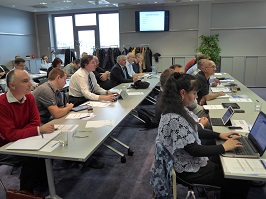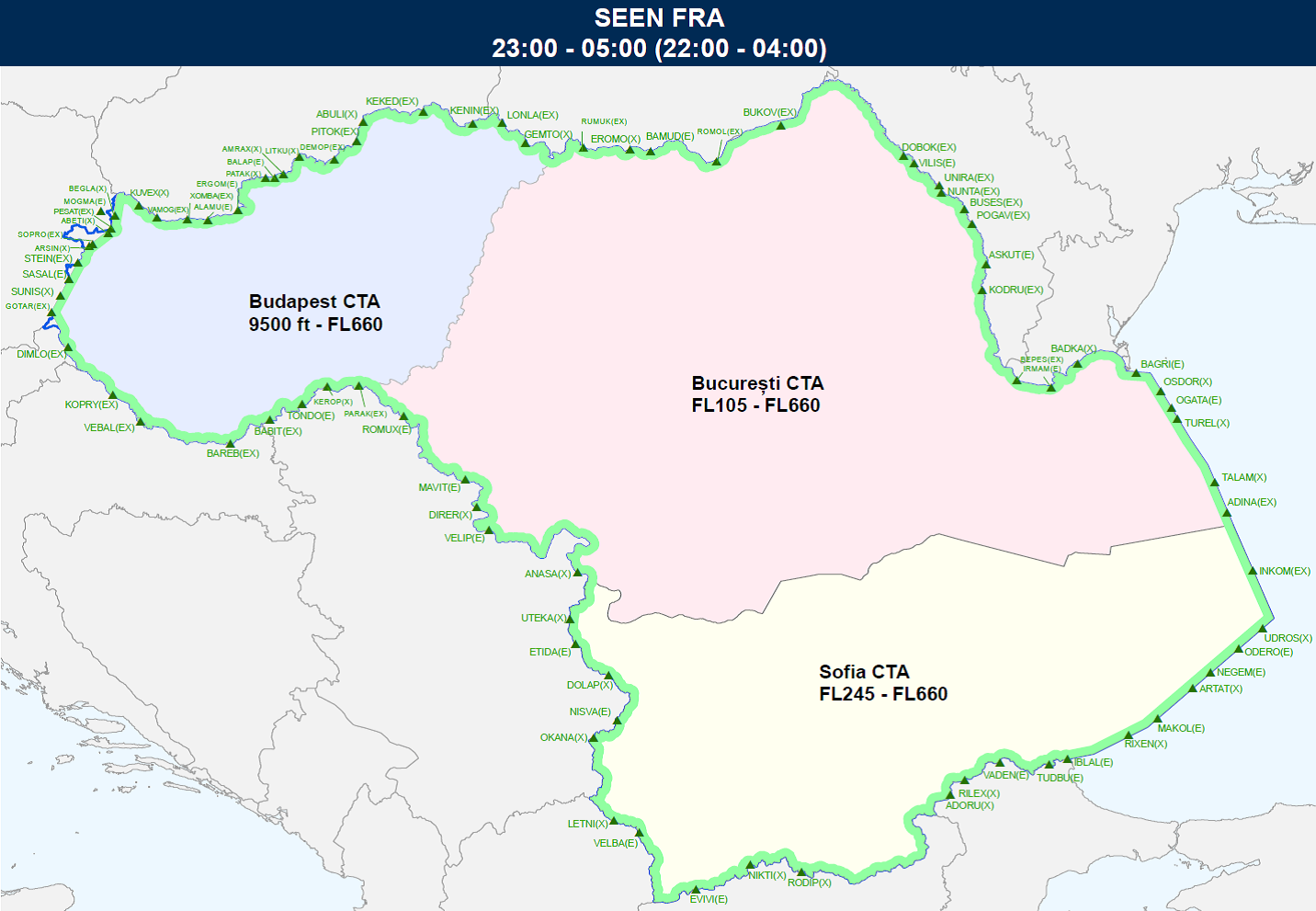FAB CE News
As of November 10th, Austro Control and Slovenia Control have successfully implemented
the first cross-border “Free Route”-Airspace without any vertical and time-based
restrictions in Europe.
The Slovenian Austrian Cross-border Free Route Airspace (SAXFRA) successfully went operational on November 10, 2016, being the first cross-border free route airspace without vertical or time-based restrictions. Virtually all airways (ATS routes) in the SAXFRA airspace
will disappear.
SAXFRA offers airspace users the opportunity to fly between predefined entry and exit points
using the most direct route possible. Airspace users will also be able to select the optimum
route and vertical profile for their requirements via intermediate points. Enabling free route
flying options in this complex and already highly optimized environment offers an estimated
savings of 13.000 kg of fuel daily and helps to reduce the CO2 emissions by 43.000 kg per day.
Free route is due to be implemented in the whole of FAB CE airspace (Austria, Slovenia,
Hungary, Croatia, Czech Republic, Slovakia and Bosnia-Herzegovina) by 2019.
SAXFRA, with its cross-border concept, time and vertical availability, represents a major step
forward in regard to the European ATM Master Plan for free route operations and follows the
roadmap to a successful implementation of Single European Sky.
The Cooperation Agreement between the FAB CE NSAs was signed in Bratislava on November 10th. The purpose of the agreement is to establish cooperation among the NSAs at FAB CE level. It defines the rules and conditions related to the exercise of the rights and obligations of the NSAs under the FAB Agreement.
- With regard to the currently ongoing discussions on the imminent re-nomination of the Network Manager, the FAB CE and DANUBE FAB CEOs jointly concluded:
- FAB CE and DANUBE FAB ANSPs appreciate the European Commission’s proactive effort suggesting further streamlining and more efficiency of the Network Manager;
- FAB CE and DANUBE FAB ANSPs welcome the EUROCONTROL response to the European Commission and consider it as a solid basis for further role of EUROCONTROL as a more autonomous and efficient body executing the responsibility of the Network Manager;
- FAB CE and DANUBE FAB ANSPs consider that the option of creating a legal entity (subsidiary created by and fully/majority owned by EUROCONTROL) is the solution for balancing a strong role of NMB in governing the Network Manager while benefiting from existing competence and impartiality of the existing Network Manager team. The FABCE and DANUBE FAB CEOs are therefore supporting this option as the ultimate goal;
- Nevertheless, if the above option is not feasible within the remaining timeframe up to 2019, the option of a functional separation (Network Manager as a functionally separated entity of EUROCONTROL) is also acceptable for re-appointment in 2019, supported by short term actions as proposed by EUROCONTROL.
 On October 13th the first FAB CE Social Dialogue 2016 was held on the premises of LPS in Bratislava. LPS CEO Miroslav Bartos welcomed all participants and stressed the importance of the Social Dialogue.
On October 13th the first FAB CE Social Dialogue 2016 was held on the premises of LPS in Bratislava. LPS CEO Miroslav Bartos welcomed all participants and stressed the importance of the Social Dialogue.
The agenda included the presentation of the High Level Plan by FCE focused on the implementation of the FAB CE Strategy. Participants were invited to submit comments. The Harmonization of social standards within FABCE was discussed, union representatives proposed a working group to go further in to detail. A guest from FABEC gave a presentation on the Social dialogue structure in FABEC, which consists of a 3 layermodel  for communication procedures.
for communication procedures.
Additional topics included the implementation of the regulation EC 2015/340 in ANS CR regarding the technical requirements and administrative procedures relating to air traffic controllers' licences and certificates as well as a report on safety performance and Just Culture.
FAB CE Free Route Progress Report
A presentation on the progress of the implementation of the Free Route Airpsace „from the Black Sea to the Black Forest“ was given. Airspace Users will benefit from more efficient routings, air traffic controllers will meet the challenge of a more complex environment.
A stepwise approach based on regional initiatives is vital in building experience to overcome the complexities involved in moving towards a seamless European airspace.
The recently initiated cross border Night FRA project between the States of Hungary, Romania and  Bulgaria represents such a step. Bridging the airspace between the two Functional Airspace Blocks of FAB CE and DANUBE FAB by spring 2017 will allow Airspace Users complete freedom to plan routes throughout the combined airspace of the three nations at night, paving the way for future expansion.
Bulgaria represents such a step. Bridging the airspace between the two Functional Airspace Blocks of FAB CE and DANUBE FAB by spring 2017 will allow Airspace Users complete freedom to plan routes throughout the combined airspace of the three nations at night, paving the way for future expansion.
All EU Member States have until the end of 2021 to implement FRA within their own airspace . To date, whilst 66% of European Area Control Centres (ACCs) have implemented FRA to some extent, only 16% have full 24h FRA, and only 25% represent cross border initiatives , both of which are required to allow Airspace Users complete freedom in planning their routes in order to maximise benefits.
|
Challenges towards large scale cross border FRA |
|
May cause major shift in traffic flows |
|
Unpredictability of traffic distribution within FRA |
|
Airspaces of different sizes and complexity |
|
Knowledge of flights way beyond national boundary |
|
Upgrading Flight Data Processing systems |
|
Advanced conflict management tools |
|
Ensuring interoperability of ATM Systems |
|
Extensive cooperation between ACCs |
|
Changes/harmonisation of working methods |
Current statistics represent a good start, yet achieving FRA across large sections of Europe as promised by a number of wide reaching partnerships brings significant challenges which should not be underestimated. It is wise to overcome these barriers through a number of well-defined and achievable milestones initially based on regional cooperation, as opposed to a “big bang” implementation. The DANUBE FAB and HungaroControl (member of FAB CE) partnership to extend their FRA projects represents a concrete step in this direction. With dedicated project teams assigned, the Concept of Operations and the implementation plan have been drafted and agreed, and Air Traffic Management System testing is currently underway between the three ANSPs, in preparation for implementation by spring 2017. This project will generate cost savings for Airspace Users in  terms of distance flown, time taken and fuel consumed, as well as reducing environmental impact.
terms of distance flown, time taken and fuel consumed, as well as reducing environmental impact.
On top of these direct benefits, the lessons learned from this trilateral inter-FAB initiative and the shared experience from each ANSP’s FRA projects will give great opportunities to expand both the geographical scope and hours of operation, as ANSPs collectively improve flight efficiency for Airspace Users.
DFS and Austro Control implemented a new method to exchange flight data that increases the accuracy and timeliness of the data displayed on the radar screens in both the Karlsruhe and Vienna control centres.
Data are no longer based on potentially outdated flight plan information. The new electronical data exchange, which is based on an OLDI specification (LATLON), will support the implementation of free route airspace.
Using the new method to coordinate data, both partners are now able to integrate the real-time planning horizons across ACC/UAC and FAB boundaries into their current operations. Previously, the trajectory data of each incoming flight had to be individually checked and manually updated as the data were mainly based on the flight plan. However, these data became less accurate as the flight progressed. Thanks to the new method, it is expected that numerous coordination activities per year will no longer be necessary. This reduces the workload of air traffic controllers, generates capacity and is a practical example of interoperability.
ATM systems have exchanged coordination data electronically for many years. In a conventional ATM environment, airspace design is based on a fixed route network and predefined coordination points (COP). In a free route environment, the number of route options is significantly higher, allowing customers to plan their flights using a variety of criteria (wind, fuel burn, etc.). By using the new method, the number and position of COPs between the sectors will no longer be relevant. The number of options will increase significantly.
To deal with this increase, a new method for the coordination of flight data regardless of COP (OLDI specification, LATLON format) has been implemented for the first time between DFS Karlsruhe UAC and Vienna ACC as of 9 June 2016. Further implementations allowing an exchange of updated trajectory information are scheduled for the upcoming months, aimed at the maximum use of this procedure with all neighbouring ACC/UAC and FABs.
Austro Control and DFS, as members of FABCE and FABEC respectively, are expecting significant benefits from this inter-FAB activity. Especially in view of the FABEC free route development and the SAXFRA (Slovenian/Austrian cross-border free route airspace) to be implemented in November 2016 under the FABCE umbrella. Each year, there are about 310,000 flights that cross the Austrian-German border, connecting two of the biggest functional airspace blocks.
Page 27 of 40
